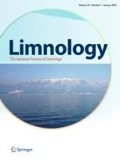Abstract
Appropriate management of macrophyte biomass via harvesting is crucial for maintaining eutrophic inland waters. However, information on the effects of macrophyte harvesting on the quality and bottom environment of these waters is limited. For our project on Lake Biwa in Japan, we focused on the pore water quality of the surface sediment as a reliable tool for estimating the effects of macrophyte harvesting. We compared the release of heavy metals and nutrients from the sediment based on the pore water quality of harvesting and non-harvesting sites. Our results suggested that macrophyte harvesting affected the water quality poorly in terms of sediment resuspension, but effectively reduced the amount of macrophyte litter on the lake bottom. Different methods of macrophyte harvesting are discussed, and cutting away only the upper section of macrophytes to avoid sediment resuspension instead of pulling up the macrophytes by the root was found to be the ideal harvesting method. In addition, sustainable harvesting to reduce the macrophyte litter on the lake bottom would be required to conserve the lake environment.







Similar content being viewed by others
References
Caraco NF, Cole JJ (2002) Contrasting impacts of a native and alien macrophyte on dissolved oxygen in a large river. Ecol Appl 12(5):1496–1509
Carpenter SR, Gasith A (1978) Mechanical harvesting of submersed macrophytes: immediate effects on littoral water chemistry and metabolism. Water Res 12:55–57
Costantini ML, Rossi L, Fazi S, Rossi D (2009) Detritus accumulation and decomposition in a coastal lake (Acquatina-southern Italy). Aquat Conserv Mar Freshw Ecosyst 19:566–574
Dadi T, Wendt-Potthoff K, Koschorreck M (2017) Sediment resuspension effects on dissolved organic carbon fluxes and microbial metabolic potentials in reservoirs. Aquat Sci 79(3):749–764
Finnegan J, Regan JT, O’Connor M, Wilson P, Healy MG (2014) Implications of applied best management practice for peatland forest harvesting. Ecol Eng 63:12–26
Hara H (2013) The concentration of aluminum in the drinking water of Shiga prefecture from April 2010 to March 2011. Annu Res Report RCSE, Shiga Univ 10(1):101–108. http://libdspace.biwako.shiga-u.ac.jp/dspace/bitstream/10441/12086/1/hara_nenpo10-2013.pdf
Kleeberg A (2013) Impact of aquatic macrophyte decomposition on sedimentary nutrient and metal mobilization in the initial stages of ecosystem development. Aquat Bot 105:41–49
Kohzu A, Shimotori K (2016) Sediment environmental studies by the application of new techniques. J Japan Soc Water Environ 39(A):289–293 (in Japanese)
Koschinsky A, Gaye-Haake B, Arndt C, Maue G, Spitzy A, Winkler A, Halbach P (2001) Experiments on the influence of sediment disturbances on the biogeochemistry of the deep-sea environment. Deep Sea Res Part II 48:3629–3651
Koyama (2016) Anaerobic digestion of submerged macrophytes—biochemical approach for enhancing the methane production. Ph.D. thesis, Soka University. file:///C:/Users/A86B9 ~ 1.KOH/AppData/Local/Temp/kogakukenkyuka_KOYAMA-MITSUHIKO(1)-1.pdf
Li C, Wang B, Yea C, Ba Y (2014) The release of nitrogen and phosphorus during the decomposition process of submerged macrophyte (Hydrilla verticillata Royle) with different biomass levels. Ecol Eng 70:268–274
Ministry of the Environment, Japan (2017) Novel lake ecosystem management by sustainable harvesting and effective utilization of aquatic weed biomass. Report of The Environment Research and Technology Development Fund 4-1406:20 (in Japanese). https://www.erca.go.jp/suishinhi/seika/pdf/seika_1_h29/4-1406_2.pdf
Murray LG, Mudge SM, Newton A, Icely JD (2006) The effect of benthic sediments on dissolved nutrient concentrations and fluxes. Biogeochemistry 81:159–178
Petr T (2000) Interactions between fish and aquatic macrophytes in inland waters. A review, vol 396. FAO fisheries technical paper. FAO, Rome
Reddy KR, Fisher MM, Ivanoff D (1996) Resuspension and diffusive flux of nitrogen and phosphorus in a hypereutrophic lake. J Environ Qual 25:363–371
Scheffer M, Portielje R, Zambrano L (2003) Fish facilitate wave resuspension of sediment. Limnol Oceanogr 48:1920–1926
Stumm W, Morgan JJ (1996) Dissolved carbon dioxide. In: Stumm W, Morgan JJ (eds) Aquatic chemistry: chemical equilibria and rates in natural waters. John Wiley & Sons, New York, pp 148–205
Takayanagi J, Sakanoi K, Sago J, Suzuki Y, Tanaka H, Abe C, Tsumori J, Nakazono T, Ozaki M, Yamashita H, Minamiyama M, Amano K, Nakamura K, Tokioka T (2004) Research on techniques for treating bottom sediment at enclosed water areas. Priority Res Projects Report (PWRI) 209:123–173. http://www.db.pwri.go.jp/pdf/D5806.pdf
Wang M, Hao T, Deng X, Wang Z, Cai Z, Li Z (2017) Effects of sediment-borne nutrient and litter quality on macrophyte decomposition and nutrient release. Hydrobiologia 787:205–215
Acknowledgements
We thank Dr. Kanako Ishikawa and other members of the Lake Biwa Environmental Research Institute and Dr. Kazuhiro Komatsu and Dr. Takayuki Satou of the Center for Regional Environmental Research, NIIES, for their cooperation in sampling and measurements. This research was supported by the Environment Research and Technology Development Fund (no. 4-1406) of the Ministry of the Environment, Japan. All the experiments in this study comply with the current laws of Japan.
Author information
Authors and Affiliations
Corresponding author
Additional information
Handling Editor: Maiko Kagami.
Rights and permissions
About this article
Cite this article
Kohzu, A., Shimotori, K. & Imai, A. Effects of macrophyte harvesting on the water quality and bottom environment of Lake Biwa, Japan. Limnology 20, 83–92 (2019). https://doi.org/10.1007/s10201-018-0556-0
Received:
Accepted:
Published:
Issue Date:
DOI: https://doi.org/10.1007/s10201-018-0556-0




